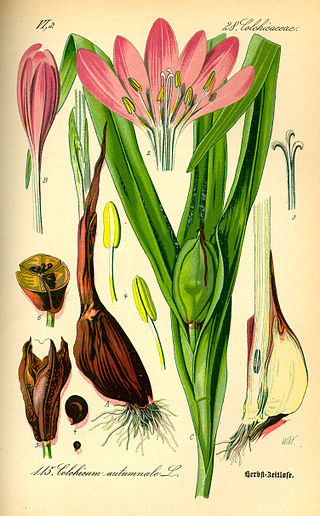
Saffron is a spice derived from the flower of Crocus sativus, commonly known as the "saffron crocus". The vivid crimson stigma and styles, called threads, are collected and dried for use mainly as a seasoning and colouring agent in food. The saffron crocus was slowly propagated throughout much of Eurasia and was later brought to parts of North Africa, North America, and Oceania.

Crocus is a genus of seasonal flowering plants in the family Iridaceae comprising about 100 species of perennials growing from corms. They are low growing plants, whose flower stems remain underground, that bear relatively large white, yellow, orange or purple flowers and then become dormant after flowering. Many are cultivated for their flowers, appearing in autumn, winter, or spring. The flowers close at night and in overcast weather conditions. The crocus has been known throughout recorded history, mainly as the source of saffron. Saffron is obtained from the dried stigma of Crocus sativus, an autumn-blooming species. It is valued as a spice and dyestuff, and is one of the most expensive spices in the world. Iran is the center of saffron production. Crocuses are native to woodland, scrub, and meadows from sea level to alpine tundra from the Mediterranean, through North Africa, central and southern Europe, the islands of the Aegean, the Middle East and across Central Asia to Xinjiang in western China. Crocuses may be propagated from seed or from daughter cormels formed on the corm, that eventually produce mature plants. They arrived in Europe from Turkey in the 16th century and became valued as an ornamental flowering plant.

Colchicum is a genus of perennial flowering plants containing around 160 species which grow from bulb-like corms. It is a member of the botanical family Colchicaceae, and is native to West Asia, Europe, parts of the Mediterranean coast, down the East African coast to South Africa and the Western Cape. In this genus, the ovary of the flower is underground. As a consequence, the styles are extremely long in proportion, often more than 10 cm (4 in). All species in the genus are toxic.

Colchicum autumnale, commonly known as autumn crocus, meadow saffron, naked boys or naked ladies, is a toxic autumn-blooming flowering plant that resembles the true crocuses, but is a member of the plant family Colchicaceae, unlike the true crocuses, which belong to the family Iridaceae. It is called "naked boys/ladies" because the flowers emerge from the ground long before the leaves appear. Despite the vernacular name of "meadow saffron", this plant is not the source of saffron, which is obtained from the saffron crocus, Crocus sativus – and that plant, too, is sometimes called "autumn crocus".

Crocus sativus, commonly known as saffron crocus or autumn crocus, is a species of flowering plant in the iris family Iridaceae. A cormous autumn-flowering cultivated perennial, unknown in the wild, it is best known for the culinary use of its floral stigmas as the spice saffron. Human cultivation of saffron crocus and the trade and use of saffron have endured for more than 3,500 years and span different cultures, continents, and civilizations.

Safranal is an organic compound isolated from saffron, the spice consisting of the stigmas of crocus flowers. It is the constituent primarily responsible for the aroma of saffron.

Human cultivation and use of saffron spans more than 3,500 years and extends across cultures, continents, and civilizations. Saffron, a spice derived from the dried stigmas of the saffron crocus, has through history remained among the world's most costly substances. With its bitter taste, hay-like fragrance, and slight metallic notes, the apocarotenoid-rich saffron has been used as a seasoning, fragrance, dye, and medicine.

Crocin is a carotenoid chemical compound that is found in the flowers of crocus and gardenia. Its oxygen content also chemically makes it a xanthene. Crocin is the chemical primarily responsible for the color of saffron.

Saffron is a key seasoning, fragrance, dye, and medicine in use for over three millennia. One of the world's most expensive spices by weight, saffron consists of stigmas plucked from the vegetatively propagated and sterile Crocus sativus, known popularly as the saffron crocus. The resulting dried stigmas, also known as "threads", are distinguished by their bitter taste, hay-like fragrance, and slight metallic notes. The saffron crocus is unknown in the wild; its most likely precursor, Crocus cartwrightianus, originated in Crete or Central Asia; The saffron crocus is native to Southwest Asia and was first cultivated in what is now Greece.

Crocus sieberi, Sieber's crocus, also referred to as the Cretan crocus or snow crocus, is a plant of the genus Crocus in the family Iridaceae. A small, early blooming crocus, it easily naturalises, and is marked by a brilliant orange which is mostly confined to the stamens and style, fading through the bottom third of the tepal. It grows wild generally in the Balkans: Greece, especially in the island of Crete, Bulgaria, Albania and North Macedonia. There are four subtypes: sieberi (Crete), atticus, nivalis and sublimis. Its cultivars are used as ornamental plants. Height: 3–4 inches (7.6–10.2 cm).

Cytotaxonomy is the classification of organisms using comparative studies of chromosomes during mitosis.

Crocus etruscus is a species of flowering plant in the genus Crocus of the family Iridaceae, endemic to woodlands of Central Tuscany (Italy). It is a cormous perennial growing to 8 cm (3.1 in) tall. The lilac flowers with purple veining and prominent orange stigmas appear in early spring.

Crocus longiflorus, the long-flowered crocus, is a species of flowering plant in the genus Crocus of the family Iridaceae, found in Southwest Italy, Sicilia, and Malta.

Iris attica, the Greek iris, is a plant species in the genus Iris, it is also in the subgenus Iris. It is a rhizomatous perennial, from the mountains of the Balkans in Europe, within the countries of Greece, former Yugoslavia, Turkey and North Macedonia. It has sage green or grey-green leaves, that are sickle-shaped, a stout short stem and 2 variable flowers, in shades from yellow to purple. They have a white or blue beard. It is often called Iris pumila subsp attica, but is classified in most sources, as a separate species, although it is closely related to Iris pumila, as a possible parent plant. It is cultivated as an ornamental plant in temperate regions.
Saffron is one of the world's most expensive spices by weight due to its difficulty to harvest. Saffron consists of stigmas plucked from the vegetatively propagated and sterile Crocus sativus, known popularly as the saffron crocus. The resulting dried "threads" are distinguished by their bitter taste, hay-like fragrance, and slight metallic notes. The saffron crocus is unknown in the wild; its most likely precursor, Crocus cartwrightianus, originated in Crete or Central Asia; The saffron crocus is native to Southwest Asia, and is believed to have been first cultivated in Iran. Greece, Turkey, and Kashmir (India) have also been suggested as possible sites of origin.
"Saffron, for example, was once less regarded than it is today because the crocus from which it is extracted was not particularly mysterious. It flourished in European locations extending from Asia Minor, where it originated, to Saffron Walden in England, where it was naturalised. Only subsequently, when its labour-intensive cultivation became largely centred in Kashmir (India), did it seem sufficiently exotic to qualify as one of the most precious of spices."

Crocus ochroleucus is species of flowering plant in the Iridaceae family. It is a cream-colored crocus native to Lebanon, Palestine and Syria.

Romulea columnae, the sand crocus, is a herbaceous perennial in the family Iridaceae. It is a small plant, with thin narrow leaves, and small scape which has small pink, pale purple or violet pointed flowers with darker veining and a gold or yellow throat. It is native to a wide area ranging from western Europe to the Mediterranean.
Crocus dispathaceus is species of flowering plant growing from a corm, with a native range from southern Turkey to northern Syria.
Crocus bertiscensis is a species of flowering plant growing from a corm, native to the northern Albanian Alps.

















